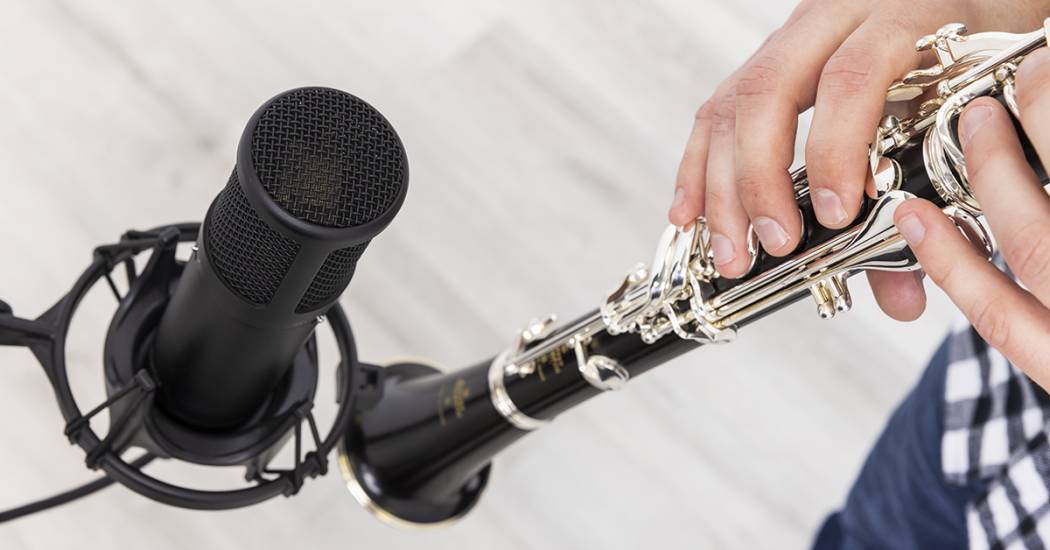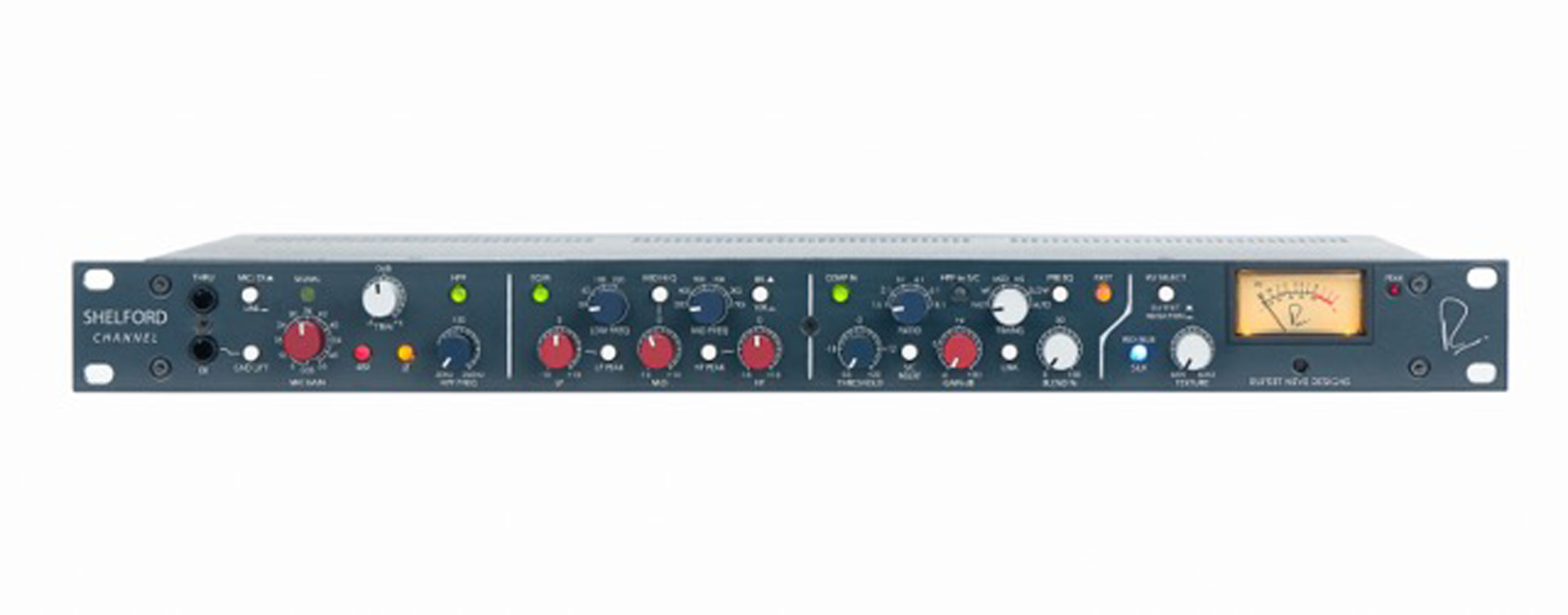
Whether you’re a career audio engineer or a clarinet player that’s ready to record at home, miking up a clarinet may leave you questioning your approach. Don’t be afraid of the clarinet, though. We’re here to help you out. After reading this article, you’ll leave the head-scratching in the past and mic your next clarinet with confidence. And, now that Sweetwater carries a comprehensive selection of band and orchestra instruments, we can help you find all the accessories and equipment to mic up and record a clarinet.
- Selecting the Right Mic
- How to Position the Microphone
- Make the Most of Your Signal Chain
- Record in the Right Space
Selecting the Right Mic
Choosing the right microphone to record your clarinet is paramount. The first thing you should do is listen to the instrument in your recording space. Listen carefully to the clarinet and assess what sort of tone the player is creating. Is it bombastic or smooth? Thin or rich? Dark or bright? Does the player move a lot when playing, or are they as still as a statue? Each of these factors will influence your microphone selection.
Microphones for Clarinet
Engineers around Sweetwater have a list of first-call microphones that they use onstage and in the studio. The mic chosen for clarinet depends largely upon the engineer’s taste, the unique timbre of the instrument, and whether the performer is mobile or stationary. Here are some mics that work extremely well for clarinet.
Instrument-mounted Mics
Choosing the Right Type of Microphone
Your choice of microphone will depend on your desired result. We’ll fill you in on microphone types and how they’ll influence the final sound. If you’re completely new to the world of recording, then our article, “How a Microphone Works,” will run through the different kinds of microphones in much greater detail.
Ribbon Microphones
With their characteristic richness and subdued high end, ribbon microphones get along with clarinets hand in glove. They’re very forgiving on clarinet and allow for less precise placement than a condenser. Ribbons can be a tad tricky to use, depending upon the acoustics of your space; but, if you use them right, you’ll get a world-class sound. You can read more about ribbon microphones in our article, “Ribbon Mics — How They Work and When to Use Them.”
Condenser Microphones
A condenser microphone has the most detailed sound out of all microphones. If you’re after a super-clear top end and high-definition pickup, then a condenser is easily the best choice. They sound their best in a good room with a stellar instrument. When used in a poorly treated room, a condenser microphone can pick up everything from the noise of your refrigerator to the cars rumbling on the road outside. You’ll also notice that a condenser microphone can even pick up the minute sounds of your pads closing over the holes.
Dynamic Microphones
A dynamic microphone is miles more forgiving than any other when it comes to room acoustics and off-axis noise pickup. Dynamic microphones usually have a cardioid or hypercardioid polar pattern — which is why they’re used so often in live settings. Cardioid and hypercardioid polar patterns are “directional,” meaning their pickup pattern focuses directly in front of the mic. For more on microphone polar patterns, be sure to grab your headphones and peruse another of our excellent microphone articles, “Microphone Polar Patterns Demonstrated — Use Your Ears.”
How to Position the Microphone
Before you put a microphone to a clarinet, think of the last time you heard one in person. You didn’t hear key noise or mouth noise, did you? That’s because you weren’t a foot away from the instrument. For a natural-sounding recording, you can’t get too close to the instrument. If you put a microphone 10 inches away from the clarinet, then you’ll get a sound with an overwhelming amount of distracting noises. But, as you move the microphone away from the instrument, you’ll hear a sound that’s more true to life.
We recommend starting somewhere around three or four feet from the clarinet. Place the microphone at the player’s shoulder height and point it toward the middle of the clarinet. That initial placement is a good starting point and provides a solid tonal foundation from which to work. If your performer is reading sheet music, then place the microphone to one side of the stand so their view remains unobstructed. Once you’ve got your starting tone, you can adjust the mic placement to achieve the sound you’re after.
For a Richer Sound
Try pulling the microphone slightly further back from the clarinet if you’re after a full and gorgeous tone. Be sure to angle the microphone slightly off-axis (away from the instrument). Doing this will minimize key noise and other distracting noises while lessening high-end pickup. What results is a rich and well-rounded tone fit for classical recordings and orchestra auditions.
For a Brighter Sound
Want to capture the audacious and cutting nature of a jazz clarinet? Then you’ll want to move the microphone closer to the clarinet. Point it toward the upper hand and let the player go to town. To maximize brightness, try a condenser microphone.
For More Room
A great-sounding space is always a plus when it comes to recording woodwinds. Try recording in stereo if you’re recording in a flattering room and want to capture the natural ambience and the instrument. Depending upon your desired result, a stereo recording can give you extra tonal flexibility that a single-mic setup can’t. At first, you can augment an existing one-mic setup with a second microphone located across the room. Other stereo configurations to consider are XY, spaced pair, or even Blumlein. For a complete list of typical stereo miking configurations with explanations, check out this article: “7 Stereo Mic Techniques You Should Try.”
For Live Situations
Working in a live situation can be tricky because you’ll want to isolate your clarinet from other players in the immediate area. For live clarinet, we recommend utilizing a direct miking technique. By mounting a microphone directly to the clarinet, you won’t have to worry about your performer moving as the music moves them. Direct miking requires some thoughtful EQing to get a natural sound. Still, the consistent sound and lessened background noise are well worth the effort.
Make the Most of Your Signal Chain
Depending upon who you ask, your recording can only be as good as the weakest link in the signal chain. With that in mind, you’ll want to run your microphone into the best possible gear. Here’s what we’d use.
Audio Interface
In today’s recording world, everything revolves around the audio interface. If you’ve never recorded before, then you’ll need an audio interface. We’ve put together a handy Audio Interface Buying Guide to help you grasp the basic principles and choose the right interface on the first try. If you already have an audio interface and are looking for something that sounds a little bit better, then our “Best Audio Interfaces for Your Home Studio” article will help your studio sound its best.
Outboard Mic Preamp
Sure, audio interfaces come with built-in mic pres. But, if you really want to take your sound to the next level, investing in a dedicated microphone preamp is the next step. Sweetwater stocks mic pres of all kinds, so you can get one with the features you need at the price you demand. If you’re like us and painstakingly research every gear purchase, then check out this in-depth Microphone Preamp Buying Guide.
Solid-state Preamps
Today’s solid-state microphone preamps offer clarity and definition that simply can’t be matched.
Tube Preamps
Old-school tube preamps offer the velvety goodness that exemplifies recordings from the golden age of analog.
Record in the Right Space
Indeed, this article is about how best to mic a clarinet. But we should cover the types of rooms in which recording should be done. The clarinet is a distinctive instrument, so it’s best to record and play in a setting that makes it sound best. If you’re not located in a concert hall, then you absolutely need to be in a treated room. The best way to do the clarinet justice would be to grab some Auralex Studiofoam Wedgies or a Primacoustic London 8 acoustic room kit.
Sweetwater Sound’s Dave Martin on Miking Clarinet
Dave Martin is Sweetwater Sound’s staff producer/engineer and a former studio owner. We asked him to weigh in on clarinet miking techniques in the studio and onstage. Here’s what he had to say.
“While it mostly depends on the person holding the instrument, a clarinet can be a bit shrill — especially in jazz and swing music. When I’m looking for a mellower tone, I pull out a high-quality ribbon microphone placed about three feet away and pointing toward the middle third of the clarinet. If I’m recording a clarinet in a classical situation, the mic choice and placement depends in large part on the role the instrument is playing. As part of an ensemble or orchestra, if I’m spot miking the clarinet at all, it’s likely to be either a DPA 4011 or a Schoeps CMC641 set to get a bit of isolation from the rest of the ensemble. If I’m recording a clarinet soloist — for example, in a clarinet concerto — I’ll try a stereo pair of mics set up either as a spaced pair about 15 inches apart and 30 inches from the instrument. If the room sounds good (like at Sweetwater Studios), I love using a pair of Austrian Audio OC818 microphones in a Blumlein configuration usually three to four feet from the musician.”
It’s All About Experimentation
Like all woodwinds, the clarinet can be a bit tricky to record. But, with enough experimentation, you can get a great sound out of any player, clarinet, or microphone. And, once you get it down, you’ll become a pro in no time! If you’ve got any questions about the techniques discussed in this article, then be sure to call (800) 222-4700 to go over the details with your Sweetwater Sales Engineer.
















